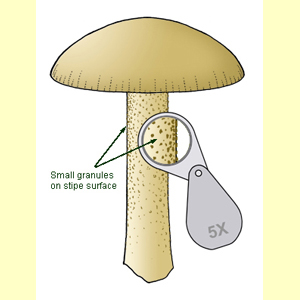
The texture of the stipe as viewed through a x5 hand lens. Some surface features are easily lost on handling, so when observing the stipe surface pick up the fruit-body by the base of the stipe, or the edge of the pileus. Hold the stipe up to the light to accentuate any hairs projecting in silhouette from the surface. The extreme base or apex of the stipe may have more pronounced surface features than the middle portion. Observe the middle portion of the stipe for this feature. Ridges or scales at the very base of the stipe are usually part of the Volva.
Choose this state if: the stipe surface ranges from pruinose (with very fine dots as if dusted with flour) to granular (with a covering of minute rounded particles that are often readily detached). Other terms which fall under this state are scurfy, powdery, mealy, pulverulent, furfuraceous or granulose.
The extreme apex of the stipe may be pruinose or granular, but the rest of the stipe is smooth, in which case choose the smooth option. Sometimes, when the stipe is not vertical, spores may fall on to the upper part of the stipe causing it to appear pruinose, when in fact the surface is smooth.
Compare to squamulose where the surface has larger scales.
